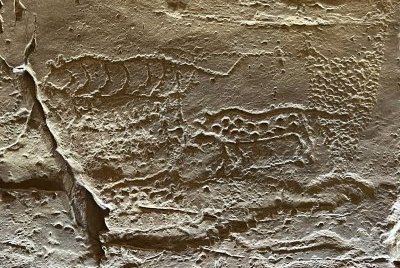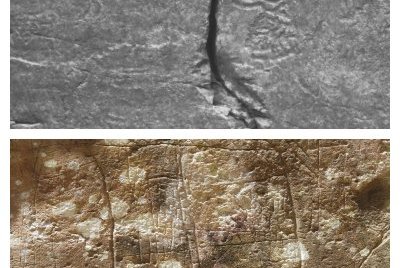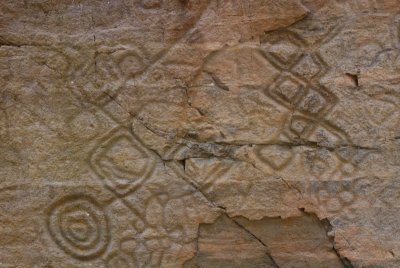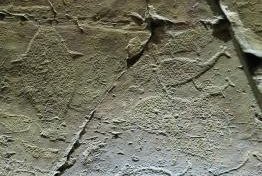Republic of Korea
Petroglyphs along the Bangucheon Stream
Community Perspective: each of the panels can be reached after a 15-minute walk from the recommended Ulsan Petroglyphs Museum, but the one to Cheonjeon-ri is slippery in bad weather. Solivagant has provided tips on how to avoid much of the hiking and get closer by car, while Els has explained how to reach the site on public transport.
Site Info
Official Information
- Full Name
- Petroglyphs along the Bangucheon Stream (ID: 5486)
- Country
- Republic of Korea
- Status
-
Nominated 2025
Site history
History of Petroglyphs along the Bangucheon Stream
- 2010: Added to Tentative List
- Added to tentative list
- Criteria
- i
- iii
Links
- UNESCO
- whc.unesco.org
All Links
UNESCO.org
- whc.unesco.org — whc.unesco.org
Related Resources
- koreanheritage.kr — Korean Heritage Magazine: Artistic Legacy of Neolithic Whale Hunters in Daegok-ri
Community Information
- Community Category
- Archaeological site: Rock Art
Travel Information
Gyeongju hotspot
Recent Connections
-
Cultural sites connected to Cliffs
"The property is located along the Bang… -
Protective engineering works against flooding
"ICOMOS considers that the main factor … -
Stand-alone Rock Reliefs
"The Daegok-ri panel is the largest roc…
Connections of Petroglyphs along the Bangucheon Stream
- Trivia
-
-
Dragon
Petroglyphs of Cheonjeon-ri "The lower part of the rock surface includes incised images and characters from the Silla Dynasty. These include depictions of a royal parade, sailing ships, horses, dragons, and, notably, the inscription of the historical record of King Beopheung of the Silla Dynasty. This inscription is considered a valuable resource for ancient historical research." -
On Passports
Released 2021 (Bangudae Petroglyphs in Daegok-ri, Ulju) pages 1-2
-
- History
-
-
Bronze Age
"These various images and inscriptions are an exceptional demonstration of this long tradition of rock engraving, extending from the Neolithic period through the Bronze Age and up to the Silla period." - AB Evaluation -
Neolithic age
"These various images and inscriptions are an exceptional demonstration of this long tradition of rock engraving, extending from the Neolithic period through the Bronze Age and up to the Silla period." - AB Evaluation -
Three Kingdoms of Korea
"This rock carving tradition was continued by Bronze Age farmers and then by members of the ancient Silla kingdom." - AB Evaluation "A total of 127 characters carved with sharp-pointed metal tools from the Silla period have been confirmed in the Cheonjeon-ri Petroglyphs. The characters are recorded in Chinese ideographic characters. The composition of the characters mainly records when, who, and why they came here. In particular, the inscription from the reign of King Beopheung of Silla (514 - 540) is engraved, so it is considered an important resource for the study of ancient history.See www.ulsan.go.kr
-
- Architecture
-
-
Stand-alone Rock Reliefs
"The Daegok-ri panel is the largest rock art site on the Korean Peninsula, at over 30 metres in length. Within this pictorial grouping, 312 petroglyphic figures have been identified. These include 16 anthropomorphic figures, 69 representations of marine animals and 108 land animals. There are also depictions of boats and various tools, including images of nets and other fishing-related tools. The level of detail of the depictions of animals, both aquatic and land-based, enable the precise species of each animal to be discerned. The whales and stages of whaling depicted in the nominated property illustrate marine fishing practices in prehistoric East Asia." - AB Evaluation
-
- Damaged
-
-
'Threatened' by Dams
"Since the construction of the Sayeon Dam in 1965, the site has been almost completely submerged every year. Before 2013, it was submerged for an average of 151 days per year, raising serious concerns among many stakeholders, in Korea and beyond, about the effects on the site. In 2014, in response to these concerns, the government decided to artificially lower the water level of the Sayeon Dam to 48 metres. Since then, the site has been submerged for 42 days per year on average, which is a significant improvement. However, the threat to its conservation remains significant. The redevelopment of the Sayeon Dam, and the ability to mitigate flood water flows using the dam, will guarantee long-term protection for the Outstanding Universal Value of the nominated property." - AB Evaluation
-
- Human Activity
-
-
Protective engineering works against flooding
"ICOMOS considers that the main factor affecting the nominated property is the annual flooding of the Daegok-ri panel. The central government has committed $47.2 million to widen the spillway and install new 47- metre-high gates. The evacuation tower will also be strengthened and upgraded to bring the dam into compliance with modern earthquake resistance standards." - AB Evaluation -
Hunter-gatherers
"The practice of rock carving in the Bangucheon region was initiated by hunter-gatherers during the Neolithic period. This rock carving tradition was continued by Bronze Age farmers and then by members of the ancient Silla kingdom." - AB Evaluation -
Petroglyphs
"The Cheonjeon-ri Petroglyphs are distributed on a rock surface 9.8 meters long and 2.7 meters high, located two kilometres upstream from Daegok-ri. Cheonjeon-ri has petroglyphs that are relatively different from those of Daegok-ri, and include nearly 625 elements, mainly geometric patterns such as diamonds, concentric circles and zig-zags, as well as Chinese characters. - AB Evaluation
-
- Constructions
-
-
Cultural sites connected to Cliffs
"The property is located along the Bangucheon Stream on the south-eastern coast of the Korean Peninsula. It extends for approximately three kilometres along this meandering waterway, in a landscape of stratified cliffs. Within this specific setting, there are two rock panels with remarkable concentrations of petroglyphs namely, the Daegok-ri Petroglyphs and the Cheonjeon-ri Petroglyphs." - AB Evaluation
-
- WHS on Other Lists
-
-
Cultural WHS set within an IUCN recognised protected area
Daegok Dam IUCN Category IV (Water Source Protection Area)
-
- Timeline
-
-
Built in the 5th millennium BC
"The petroglyphs of the nominated property show a wide range of images engraved by successive generations of local artists, using stone and metal tools, spanning both the prehistoric and historic eras, from 5,000 BCE to the ninth century CE." - AB Evaluation
-
- WHS Hotspots
-
-
Gyeongju hotspot
The Ulsan Petroglyph Museum is about 30 kilometers from Gyeongju
-
- Science and Technology
-
-
Recently discovered
"These rock panels were discovered in 1970 and 1971." - AB Evaluation
-
News
No news.
Recent Visitors
Visitors of Petroglyphs along the Bangucheon Stream
Community Reviews
Show full reviewsZoë Sheng
Petroglyphs Along The Bangucheon Stream
Petroglyphs along the Bangucheon Stream (Nominated)
I wanted to visit this place years ago, 2015?, but the local bus line to get there was horrible. I ended up in the town of Ulsan which is easy enough, waiting for the local bus...well the display was digital (new and flashy back in the days) and the bus line wasn't shown. Eventually it did but the display was showing the time to arrive at this bus stop which is another hour...omg. Well, crazy as it is, a French guy and his Korean gf walked by so I asked about the bus and she checked her app to know it's another hour and gave me info on the return. Well, this wasn't good. TLDR don't go there with public transportation unless you have heaps of time or know the actual times ... best would be with Korean knowledge. Anyhow, I see most people taking a taxi there but I just went to Busan to cool off which Gamcheon Culture Village helping a lot there.
A few years later I drove around Korea by myself and voila I made it to Ulsan. I obviously went to the stream and the first thing you want to do is visit the museum. It was quite busy with school children on that day so my impressions are a bit mixed. It's definitely a must-see though. I then drove further out (it's walkable) and parked just in front of the stream. It's not really official parking and only a few will park but …
Keep reading 0 commentsFrederik Dawson
Petroglyphs Along The Bangucheon Stream
Petroglyphs along the Bangucheon Stream (Nominated)

Summer 2023 while driving on the highway from Busan to Gyeongju, I decided to take a meaningful detour. Along the way lie two important sites, the famous Tongdosa Temple, a UNESCO World Heritage Site, and the lesser-known Bangudae Petroglyphs, at that time on UNESCO’s Tentative List. Curious to explore something more off the beaten path, I headed toward Bangudae. The road leading from the highway to the Bangudae Petroglyph Museum was freshly paved and well-kept, likely part of a beautification effort as the site prepares for potential World Heritage status. Instead of stopping at the museum immediately, I continued on to a small alley where a walking trail to Bangudae begins. The path runs alongside a peaceful river, offering a gentle immersion into the Korean countryside. I passed a lively riverside restaurant where a group of Korean hikers were enjoying cold beers after a long walk. Further along, I encountered two local tombs and even a site of dinosaur footprints, a reminder of the deep time embedded in this region.
At the end of the trail, I finally reached the Bangudae Petroglyphs, carved into a cliff across the river. But from that viewing point, the carvings were difficult to make out. The famous images of whales and ancient hunting scenes were nearly invisible to the naked eye. Honestly, it was a bit underwhelming. Returning to the museum, however, changed everything. Inside, I found a detailed replica of the Bangudae Petroglyphs, and as I studied it, a wave of …
Keep reading 0 commentsEls Slots
Petroglyphs Along The Bangucheon Stream
Petroglyphs along the Bangucheon Stream (Nominated)

The ‘Petroglyphs along the Bangucheon Stream’ (the adjusted official name) will be South Korea’s nomination for 2025. Especially at the Ulsan Petroglyphs Museum, located at the site entrance, they are confident that it will get inscribed. Information panels detail the milestones in the nomination process, a map is showing all rock art WHS worldwide, and I was presented with a booklet explaining the site’s OUV. I wouldn’t say it’s a great site from either an artistic or visitor experience perspective. Still, they have done their best to provide a satisfying visit that will take some 2.5-3 hours if you take in all components (the museum, the two panels of petroglyphs, and the dinosaur tracks) on foot. And it's all free.
The exhibition at the museum is a preview of what we will see in the nomination dossier: a compelling story about how the local people during the Late Neolithic and Early Bronze Age depended on whale hunting for their livelihood. They “loved” the whales so much that they made numerous engravings on the rocks by the riverside, possibly as a form of worship. Some sources say it's also the earliest evidence found so far of the practice of whaling worldwide, although this claim isn't repeated in the proposed OUV statement (it speaks of "a subject only rarely found in rock art worldwide").
The main set of petroglyphs is called Bangudae. I only succeeded in getting the upper photo of the two posted with this review …
Keep reading 0 commentsSolivagant
Petroglyphs Along The Bangucheon Stream
Petroglyphs along the Bangucheon Stream (Nominated)

A few points additional to the previous review
a. The museum was opened in 2008 and is a fine example of the money and effort which S Korea is prepared to spend on providing Musea at its (T)WHS sites (and maybe at others too?) Designed in an elongated “sinuous” shape it is meant to represent the Whales which figure on the Bangudae carvings and an, otherwise architecturally unnecessary, “Tail” has been affixed to one end of the roof of the building to assist this representation!
b. We were almost the only visitors present in mid week early afternoon and were provided with literature in English by the 3 staff – who spoke no English, making it a bit difficult for me to establish which of the 2 rock carvings might be the better to concentrate on if we didn’t have time to visit both! We were ushered into a plush cinema and shown a video with English dubbing. Part of this showed the museum’s opening ceremony attended by hordes of besuited “executives” – Unfortunately I missed catching the exact figure given on how many millions (trillions?) of Won the whole thing cost.
c. The museum does indeed contain good fibreglass replicas of the 2 rock faces and that for Bangudae is worth examining in detail since the later views of the real thing are very limited. The claim is that the representations (created from late Neolithic to the early Bronze age – 7000-3500 ybp) “include the oldest …
Keep reading 0 commentsKyle Magnuson
Petroglyphs Along The Bangucheon Stream
Petroglyphs along the Bangucheon Stream (Nominated)

On the first day of July, early afternoon, rain pouring, we arrived at Ulsan Petroglyphs Museum. Once I entered the museum (in part as shelter), I was immediately impressed. This history lesson will be different than most museums or historic sites in Korea. Nothing about Confucianism, Buddhism, seowon, fortresses, or tombs!
The museum really is fantastic, sure not much is in English, but the replica copies of both petroglyphs are superb. The video in the small theater is informative and quite dramatic, some English. The museum is where you should start, it probably takes 30 to 45 minutes. After the museum you have two choices.
1) 1.2km hike to Bangudae Petroglyphs
2) 1.2km hike to the Petroglyphs in Cheonjeon-ri
Because of the heavy rain and a warning that Cheonjeon-ri in this rain could be dangerous, the museum staff recommended the short hike to Bangudae Cliff. The walk is very pleasant, and quite scenic along the Daegokcheon Stream (even a small spot with dinosaur footprints). Once you are in view of Bangudae cliff, there are high zoom installed binoculars. Since you are on the opposite side of the stream, the distance makes seeing the petroglyphs difficult (especially in heavy rain). With my new camera (40X zoom) I could see them fairly well, but high zoom + heavy rain does not equal great pictures. The picture here is from the replica, but several of my pictures were focused on this scene, and with zoom I could make it out with difficulty.
Despite …
Keep reading 0 comments